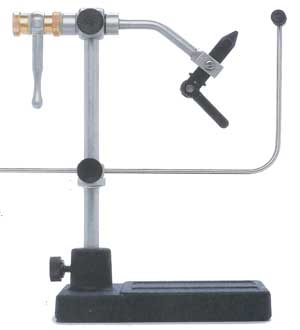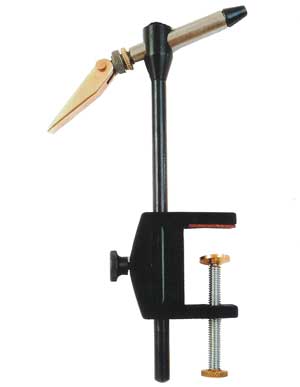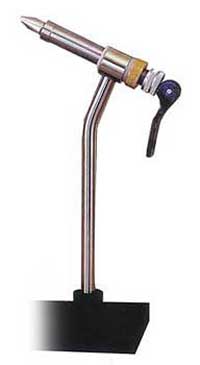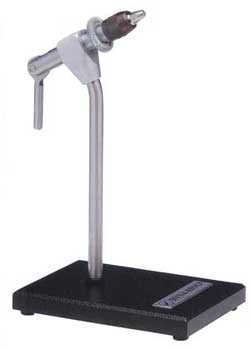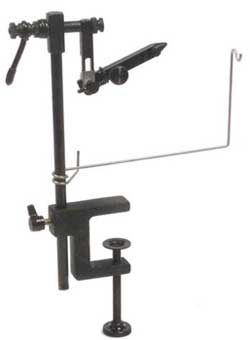Get a Grip
FLY TYING looks intimidating. Creating something a fish might eat out of a hook and pieces of strange materials can seem like alchemy to many beginners. And it is a sort of alchemy; it blends equal parts of science, art, craft, and folklore. Happily, it’s not at all difficult to become a proficient fly tier. With a little guidance and practice, almost anyone can make flies that look good and catch fish.
It has been said that it’s a poor craftsman who blames his tools. But it is equally true that working with poor tools can make even a master craftsman produce poor results. The most essential tool you’ll need to tie flies — it’s certainly the first tool you will purchase — is a vise. Let’s begin by examining the parts of a vise, and then discuss which vises do the best job of tying the various types of flies.
Jaws (Not the Movie)
The jaws are the business end of the vise. These are the things that grasp the hook. A good set of jaws should be easily adjustable and firmly clamp the hook without requiring you to exert too much force on the jaw-closing mechanism. Here are some of the common mechanisms used to close the jaws on a fly-tying vise.
Draw-Collet Jaws These type of jaws ride in a steel tube. A lever with a cam is attached to the back end of the jaws and draws them into the tube, squeezing them closed. This is the most common mechanism used on beginner vises as well as a few vises designed for experienced tiers.
Cam-Lever Bar Jaws These jaws consist of a pair of tapered steel bars with an adjustable bolt joining the bars near the front. A lever attached to a cam is placed between the back of the jaws. When you rotate the lever, the cam spreads the back of the jaws apart, causing the tapered tips (where the hook gets clamped) to close. The bolt in front lets you adjust the width of the closed jaws so you can use a wide range of hook sizes. Griffin Enterprises, Renzetti, and many other manufacturers use this mechanism. (Regal uses a variation of this, with the cam forcing spring-loaded jaws apart.)
Screw-Collet Jaws The screw-collet mechanism isn’t seen too much these days except on the cheapest vises. A screw takes the place of the cam in a draw-collet vise. Turning the screw tightens the jaws using the same principle of pulling the jaws into a tube.
These are the types of jaws you’ll find on the vises at your local fly shop. Generally speaking, the better vises — even beginner vises carrying more affordable price tags — have either cam-lever bar or draw-collet jaws. These mechanisms are durable and hold hooks very firmly.
Pedestal or C-Clamp?
A fly-tying vise comes with either a pedestal base to set the tool on top of a table, or a C-clamp to attach the tool to the edge of the table. (Some manufacturers offer both bases with each vise.) What’s the difference, and should you care?
A pedestal base is typically made of a big slab of heavy metal. The weight helps hold the vise steady, but it also makes carrying the vise a bit of a weighty pain in the butt, especially if you plan to take it with you on a trip. A pedestal, however, will allow you to tie on any flat surface.
A C-clamp is light and holds the vise rock-steady (or at least as steady as the table to which it is affixed). You can easily toss a C-clamp in with your socks and underwear for a trip, and it will add very little weight. But you’d better hope that the edges of the table at your destination are narrow enough to accommodate the width of your C-clamp.
After years of dragging fly-tying kits all over the country, I have come to prefer pedestal bases. The extra weight is a minor inconvenience compared with the tie-anywhere flexibility the pedestal confers. I’ve known more than a few tiers to arrive at their destinations and find that the tables all had edges too thick for their C-clamp mounts. (Sometimes there were no tables at all, only dressers and desks in the hotel rooms.) This is also a regular problem at fly-tying classes; folks show up with C-clamp vises that don’t fit the tables provided. This isn’t a problem with a pedestal vise.
Choose Your Flies, Then the Vise
There are all sorts of vises on the market. Some are at the extreme of bare functionality; others offer all sorts of gimmicks that may or may not make tying easier. And, of course, the prices of vises range from very inexpensive to surprisingly costly. If you know little or nothing about fly tying, how can you make a rational choice when choosing your first vise?
Perhaps the most important consideration when selecting a vise is knowing what you’ll need your vise to do. Its primary function is, of course, to hold a hook while you lash fur and feathers in place. A vise that can’t hold the hook steady is worse than worthless.
Most of the better vises — even introductory vises — are designed to hold a wide range of hook sizes, but there is a limit to this do-everything versatility. You’ll be able to narrow down the search for your first vise if you can determine the type of flies you will usually be tying. For example, if you spend most of your time chasing trout on Western waters, your average hook will run from size 4 down to size 22 or even smaller. If you spend your days fishing for striped bass, snook, or redfish, your hooks will be heavy-wire saltwater models in sizes 4 to 3/0. Thinking about the type of flies you will tie will help you make a more informed decision when plunking down your hard-earned cash for a vise.
You’ll notice that one or two brands of high-quality vises are not mentioned in this article. This is not an attempt to slight anyone. The goal of this article is to discuss introductory vises, and so I am including only those companies that offer tools that fit this category.
Trout Flies A vise with fairly narrow or pointy jaws makes it much easier to tie small flies. Most of the draw-collet vises work quite well for this. If possible, have the sales clerk set up the vise so you can try a bunch of different hook sizes in the jaws and get a feel for how your hands work with the tool. Pay particular attention to how deeply you can place the hook bend between the jaws while still being able to tie materials in place. Select a vise with narrow jaws that can grasp a good amount of the hook bend and still allow ample room to tie. Avoid any vise in which you can only perch the hook in the tip of the jaws; this can cause the metal to chip and ruin the vise.
Bass Bugs and Salmon Flies Look for a vise that can hold fairly large hooks and has a head that can move to different angles from horizontal to vertical. Bass and salmon flies range in sizes 8 to 4/0, but generally are made of fine wire for their sizes. One convenient feature to look for is a groove on the inside of the jaws. (It looks like a hole through the jaws when they’re closed.) You can set the bend of a large hook in the groove for maximum security while relieving some of the stress off the jaws.
Tying bass bugs and other flies that use spun-and-packed deer hair requires a vise that can hold large hooks very tightly. You have to pull the thread pretty hard to get the hair to spin and flare properly. A vise that doesn’t grip tightly enough will let the hook slip when you pull on the thread, which makes tying difficult or impossible.
If you see lots of bass bugs in your future, skip any cheap beginner vise that uses a cam lever at the rear to draw the jaws back into a tube collet to close them. Such vises will hold a bass-bug hook tightly enough when they’re new, but if you tie a lot of bass bugs, the jaws of such vises will tend to bend and spread over time. Eventually, the vise will be ruined. The first such vise I bought many years ago suffered this problem after just a couple of months of use.
Earlier I recommended pedestal-mounted vises for their ease of use. Many deer-hair bug aficionados, however, prefer vises with C-clamps. These tools are more stable and you can put more tension on the thread when spinning deer hair.
Saltwater Flies You can tie lots of saltwater patterns using the same vise you might use for bass or salmon flies, but a good saltwater vise needs to hold really big hooks made of very thick wire. Because of the wide range of sizes and wire thickness, a vise with adjustable jaws is an excellent investment.
If you plan to tie lots of saltwater flies, consider investing in a vise with a head that rotates. This type of tool is called a “rotary vise.” Flies that feature epoxy-coated heads, such as Surf Candies, are much easier to make with a rotary vise.
In the end, it pays to take some time to shop around. Try as many different styles and brands of vises as you can before settling on your purchase. Seek out the advice of fly-tying friends, and examine the different vises used in local tying classes. There are a lot of different vises from which to choose, and there’s one that is right for you.

